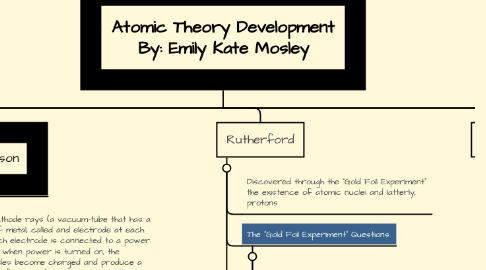
1. Democritus
1.1. Existed around 400 B.C
1.2. Hypothesised and presumed that Earth, FIre, Wind, and Water created everything and many scientists followed suit in this belief
1.3. Believed all matter was made up of indivisible particles called "atoms" (this is derivative from the Greek word "atomos" meaning indivisible"
1.4. Different atoms have different sizes and properties
2. Dalton
2.1. Dalton's Atomic Theory
2.1.1. Atoms cannot be created, divided into smaller particles, or destroyed
2.1.2. In a chemical reaction atoms combine in definite whole number ratios to make compounds
2.1.3. All elements are different
2.1.4. All atoms of a given element are identical having the same size and chemical properties
2.1.5. All matter is composed of extremely small particles called atoms
2.1.6. Atoms are indivisible
2.1.7. All atoms have the same mass
2.2. Dalton's Atomic Model
2.2.1. Atoms were tiny solid balls
2.2.2. Atoms could not be broken apart
2.3. Atomic Laws
2.3.1. Law of Conservation of Mass: States that matter cannot be created or destroyed in any physical or chemical process, just transferred
2.3.2. Law of Definite Proportions (Law of Constant Composition): When atoms combine to form molecules, the ratio of mass of atoms is constant (same ratio of elements is the same compound)
2.3.3. Law of Multiple Proportions: Elements can combine in different ratios, which forms different compunds
3. Thomson
3.1. Used cathode rays (a vacuum-tube that has a piece of metal, called and electrode at each end. Each electrode is connected to a power source, when power is turned on, the electrodes become charged and produce a stream of charged particles across the tube) to test Dalton's Solid ball method
3.2. Stated that Dalton's Solid-ball model could be broken into smaller pieces
3.3. Thomson's Experiment:
3.3.1. Thompson predicted that if the tube was put in a magnetic field, a straight path would form in a stream
3.3.1.1. Instead he found that the path curved AWAY from the the negatively charged plate and TOWARDS a positively charged plate
3.3.2. This occurred because like charges REPEL each other as where unlike charges ATTRACT each other.
3.3.3. Thompson came to the realization that the particle stream must have had electrons in them.
3.4. Thomson's Plum Pudding Model
3.4.1. Thompson's Plum Pudding model consists of oa positive sphere that contains negatively charged electrons randomly placed inside.
3.4.2. Theoretically, the atom is neutral due to an equal number of positive and negative charges
4. Rutherford
4.1. Discovered through the "Gold Foil Experiment" the existence of atomic nuclei and latterly, protons
4.2. The "Gold Foil Experiment" Questions:
4.2.1. What would happen if an atom was a solid sphere?
4.2.2. What did it mean that almost all of the particles passed through the foil?
4.3. Rutherford's Model:
4.3.1. -Contains a nucleus that is positively charged nucleus
4.3.2. -The mass of the atom is almost entirely packed in the nucleus but is densely packed and requires very little space
4.3.3. -The most volume required is by the electrons and carry a negitave charge
4.3.4. -The atom is mostly empty (except where small electrons are)
